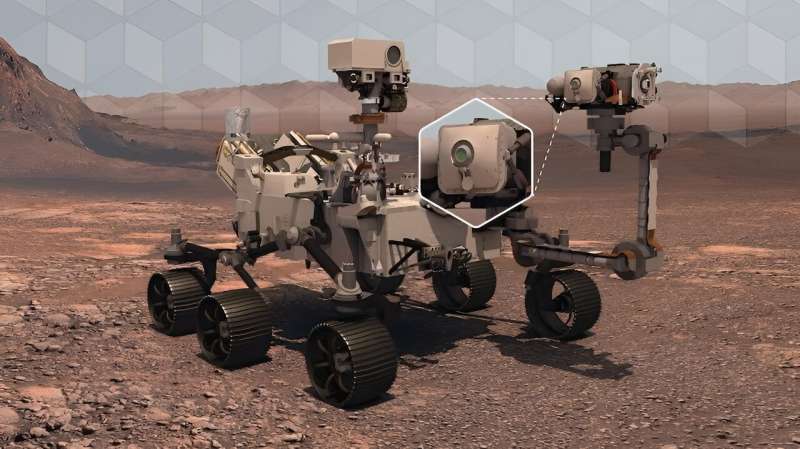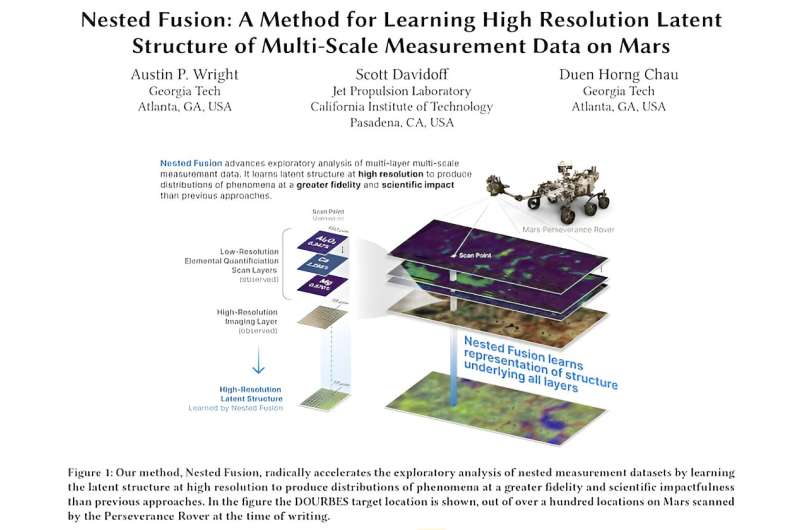
Credit: NASA
A new algorithm tested on NASA’s Perseverance Rover on Mars could lead to better forecasting of hurricanes, wildfires and other severe weather events that affect millions of people around the world.
Georgia Tech Ph.D. student Austin P. Wright is the first author of the paper introducing Nested Fusion. A new algorithm improves scientists’ ability to search for past signs of life on the Martian surface.
This proposal supports NASA’s Mars 2020 mission. In addition, scientists from other fields working with large, redundant databases can use Nested Fusion methods for their studies.
Wright presented Nested Fusion at the 2024 International Conference on Knowledge and Data Mining (KDD 2024) where it was a runner-up for the best paper award. The work is published in the newspaper Proceedings of the 30th ACM SIGKDD Conference on Knowledge Discovery and Data Mining..
“Nested Fusion really helps researchers in many different areas, not just NASA scientists,” Wright said. “This method detects complex datasets that may be difficult to obtain in general during the early stages of analysis.”
Nested Fusion combines datasets with different resolutions to produce a high-resolution visual distribution. Using this method, NASA scientists can easily analyze multiple datasets from different sources at the same time. This could lead to rapid studies of the structure of Mars to find clues about past life.
Algorithm shows how data science affects traditional science fields like chemistry, biology and geology.
In addition, Wright is developing applications of Nested Fusion to model climate change, plant and animal life, and other concepts in the earth sciences. A similar approach can integrate overlapping datasets from satellite imagery, biomarkers, and weather data.
“Users have extended Nested Fusion and similar algorithms to world-class technologies, which we’ve received very positive feedback from,” said Wright, who studies machine learning (ML) at Georgia Tech.
“Cross-correlational analysis takes a long time to do and is not done in the early stages of research when patterns emerge and create new hypotheses. Nested Fusion enables people to discover these patterns earlier very much.”

Credit: Proceedings of the 30th ACM SIGKDD Conference on Knowledge Discovery and Data Mining. (2024). DOI: 10.1145/3637528.3671596
Wright is the data science and ML lead for PIXLISE, the software that NASA JPL scientists use to study data from the Mars Perseverance Rover.
Perseverance is using the Planetary Instrument for X-ray Lithochemistry (PIXL) to collect data on Mars’ mineral composition. PIXL’s two main instruments that achieve this are the X-ray Fluorescence (XRF) Spectrometer and the Multi-Context Camera (MCC).
When PIXL scans a target area, it creates two linked datasets from the features. XRF collects the basic type of a good sample. MCC produces images of the sample to collect visual and physical data such as size and shape.
One XRF scan corresponds to approximately 100 MCC image pixels for each scan point. The unique resolution of each device makes mapping between overlapping data sets a challenge. However, Wright and his colleagues designed Nested Fusion to overcome this problem.
In addition to advances in data science, Nested Fusion improves the performance of NASA scientists. Using this method, a single scientist can make a first estimate of the mineral composition of a sample within hours. Before Nested Fusion, the same task required days of collaboration between teams of experts on each different device.
“I think one of the biggest lessons I’ve learned from this job is that it’s important to always base my ML and data science challenges on the concrete use cases of our colleagues,” Wright said.
“I learn from colleagues what aspects of data analysis are important to them and the problems they face. By understanding these issues, we can find new ways to frame and create problems in science. of data.”
Nested Fusion won second place for best paper in the applied data science track. Hundreds of other papers were presented in research series, seminars and conference proceedings.
Wright’s mentors, Scott Davidoff and Polo Chau, co-authored the Nested Fusion paper. Davidoff is a principal research scientist at NASA’s Jet Propulsion Laboratory. Chau is a professor in the Georgia Tech School of Computational Science and Engineering (CSE).
“I was very happy that this work was recognized with the best paper award,” said Wright. “This type of applied work can sometimes be difficult to find the right academic home for, so to find a community that appreciates this work is very encouraging.”
Additional information:
Austin P. Wright et al, Nested Fusion: An Approach to Study High Resolution Latent Structure of Multi-Scale Measurement Data on Mars, Proceedings of the 30th ACM SIGKDD Conference on Knowledge Discovery and Data Mining. (2024). DOI: 10.1145/3637528.3671596
Provided by the Georgia Institute of Technology
Excerpt: Algorithm used in Mars rover helps Earth scientists see data in a new way (2024, September 20) found on September 21, 2024 from https://phys.org/news/2024-09 -algorithm-mars-rover-scientists-earth html
This document is subject to copyright. Except for any legitimate activity for the purpose of private study or research, no part may be reproduced without written permission. Content is provided for informational purposes only.
#algorithm #Mars #rover #helps #scientists #Earth #data


